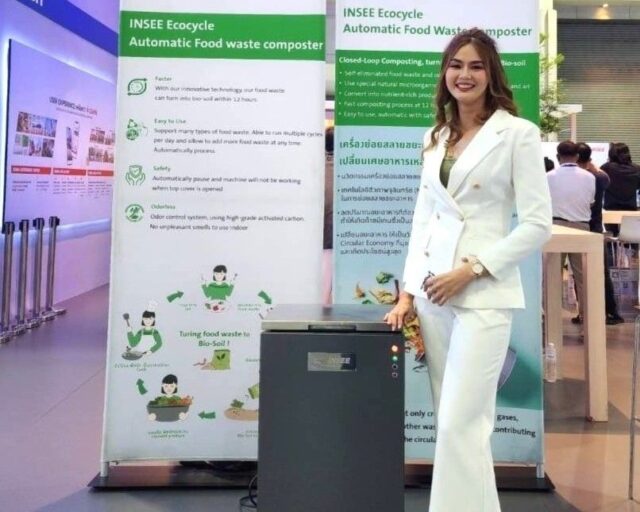Food waste continues to be a pervasive problem both in Thailand and globally. It’s estimated that food and other organic materials account for more than 60 percent of waste generated in the Kingdom, according to the Pollution Control Department. The negative impact this has on the environment is staggering.
For starters, food waste in landfills around the world is responsible for approximately eight percent of greenhouse gases which are a key cause of the ongoing climate crisis. Additionally, it can contaminate other types of waste materials, such as non-recyclable plastics, that could be used by waste-to-energy technology.
Simply put, food waste not only creates greenhouse gases, but it is preventing other waste sources from contributing to the circular economy. Clean plastic waste is able to power cement kilns as an alternative to fossil fuels. However, this becomes much more difficult if it has been contaminated by food refuse. What’s worse is the fact the plastic will just sit in landfills for years where it is at risk of being washed away into streams and rivers that lead into the ocean.
Proper segregation of food and other kinds of organic waste could significantly reduce these issues and decrease the burden currently placed on waste management in Thailand. Instead of causing problems, these unwanted leftovers can even be used to feed gardens which would create a positive impact on the ecosystem.
Understanding the challenges involved with waste management, we wanted to find a solution that could support clients, lessen the burden on the environment and contribute to Thailand’s circular economy goals. That is where the INSEE Ecocycle Food Waste Composting project comes in.
This innovative composting technology transforms food waste into bio-soil in only 12 hours. Developed in conjunction with a leading institute in Thailand and utilizing our proprietary microorganisms, INSEE Ecocycle Food Waste Composter allows the waste segregation process to begin at the source as opposed to pushing this further down the management chain.
The exciting breakthrough in waste segregation supports us in building sustainability partnerships that can help more stakeholders manage food waste properly. This, in turn, increases the recycling rate yield while improving efficiency in managing combustible waste for energy recovery.
Also Interesting: Here’s the eco-friendly way Thailand destroyed $11 million worth of counterfeit products
How does the INSEE Ecocycle Food Waste Composter work?
The INSEE Ecocycle Food Waste Composter is quite simple to use and removes many of the issues people have composting. Most notably, it doesn’t stink.
You start by placing our bio-additive and sawdust to the machine. Interestingly, the bio-additive only needs to be introduced the first time you operate the composter. There is no need to repeat that step once completed.
After that, you put the food waste in and let the magic happen. Over the next 12-24 hours, these materials are broken down with 80-90 percent being eliminated. Whatever is left can be used as bio-soil fertilizer which provides nutrients to fruits, vegetables or other types of plants.
Anyone who has tried composting knows the smell can be quite pungent. However, the INSEE Ecocycle Food Waste Composter combats this through the use of a carbon filter that has been designed to continuously clean the air. This “air fan” eliminates any odors coming from the food waste ensuring the process doesn’t stink.
It’s also important to know that the machine only uses bio-organisms which do not have any effects on people or the environment. Finally, the technology is powered by electricity but only requires a minimal amount to operate. This means the INSEE Ecocycle Food Waste Composter is cost efficient while not creating other environmental problems by using unnecessary amounts of power.
Preventing food waste and closing the circular economy loop
Eliminating food waste calls for us all to work together. The easiest way to do this is by only buying and ordering what you can actually consume. For example, instead of ordering everything on a buffet menu at the start, pace yourself by requesting a few items at a time. This prevents over-ordering, a key source of food waste.
Consumer reduction could eventually lead to a decrease in food production which would allow for less intensive farming practices to be utilized. The impact of this is substantial with benefits spanning from the conservation of water supplies to fewer greenhouse gases being emitted from food transportation.
Of course, some food waste is likely to be produced on a day-to-day basis, and that is where composting comes in. By embracing technology like the INSEE Ecocycle Food Waste Composter, what is sent to landfills will be significantly reduced or even eliminated entirely.
Composting those unwanted leftovers also creates fertilizer which can feed the fruits and vegetables that just may become your next meal one day. By ensuring nothing goes to waste, together we can close the loop of the circular economy together.
Keep Reading: Meet the Philippine recycling startup that wants to declutter Metro Manila


































